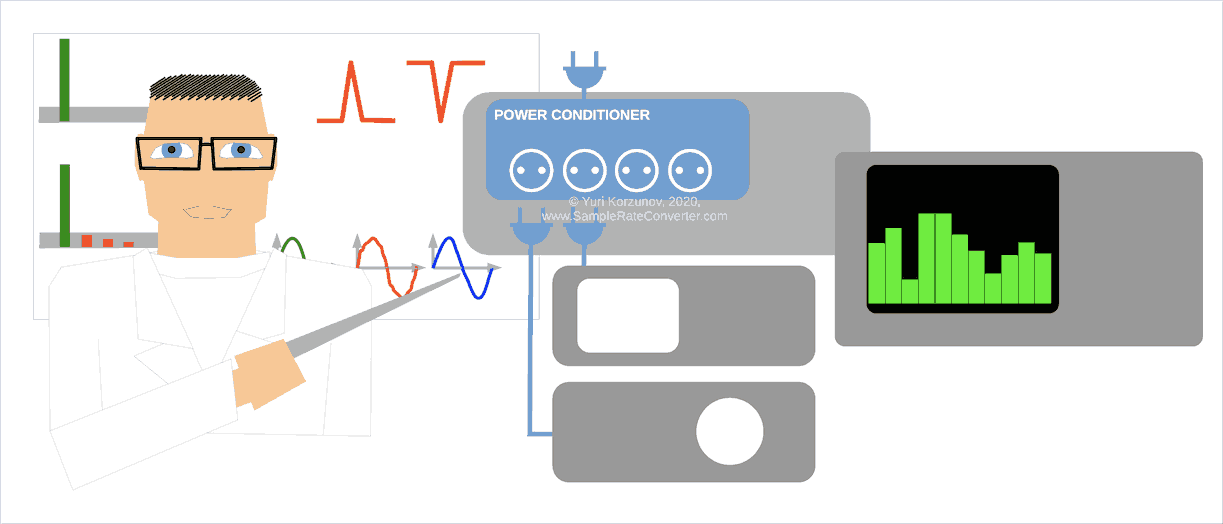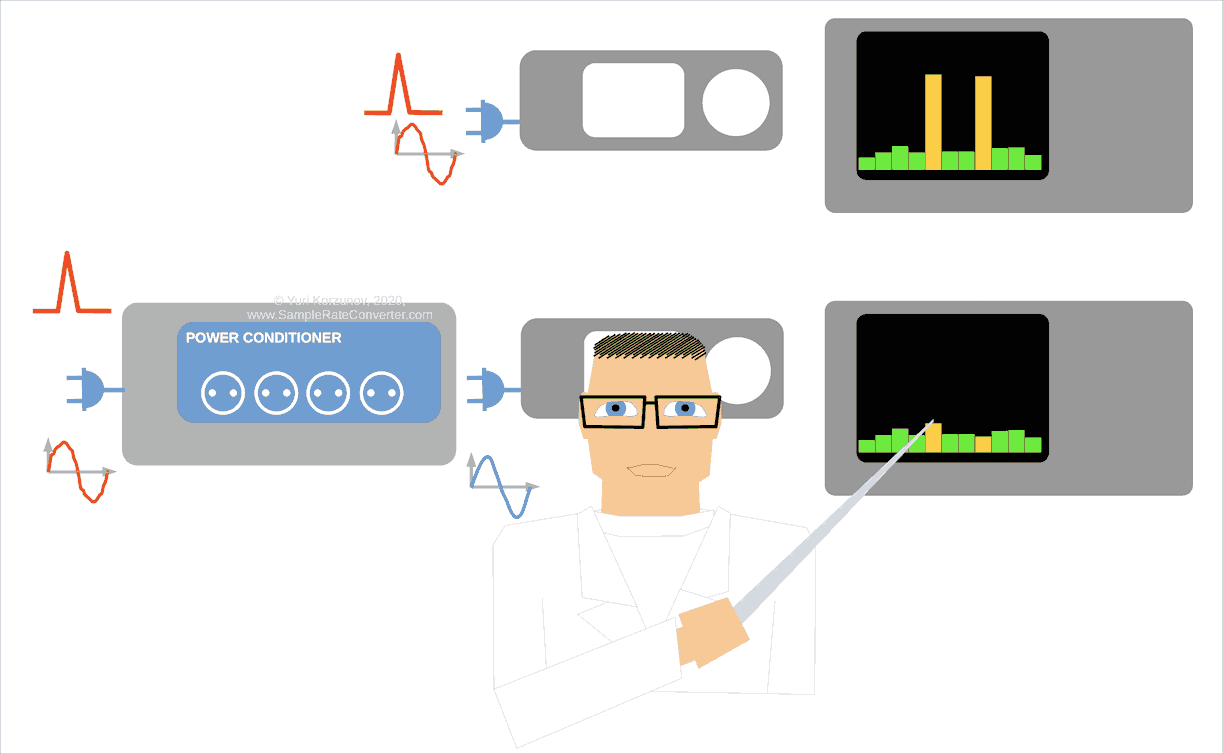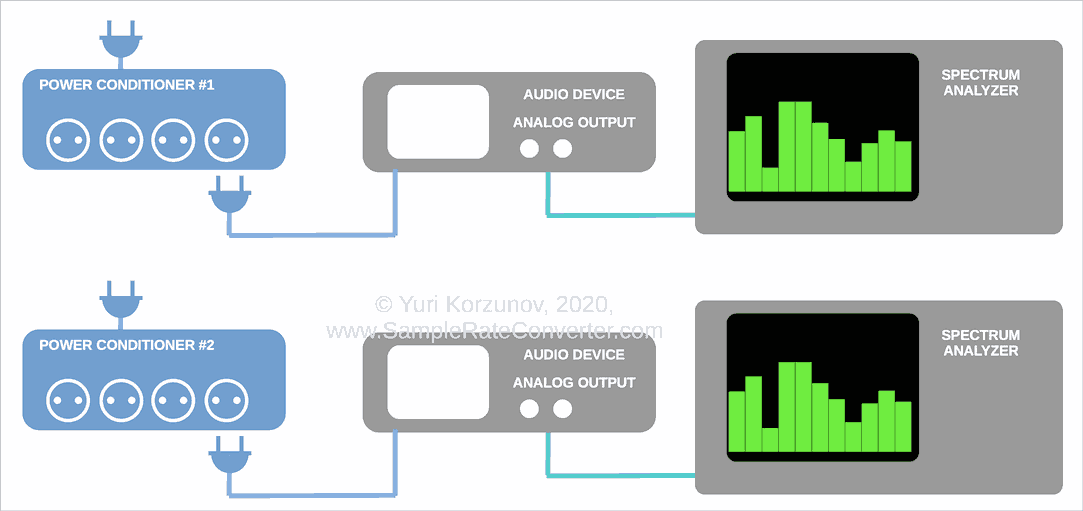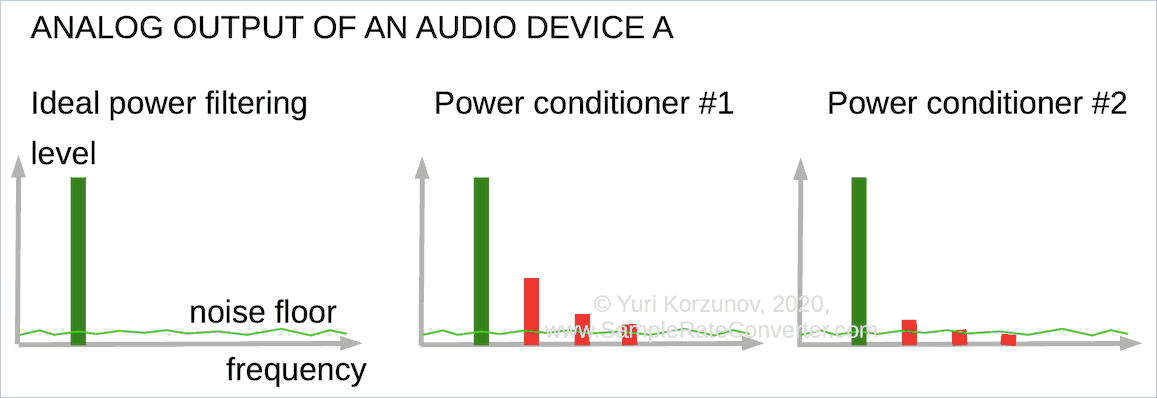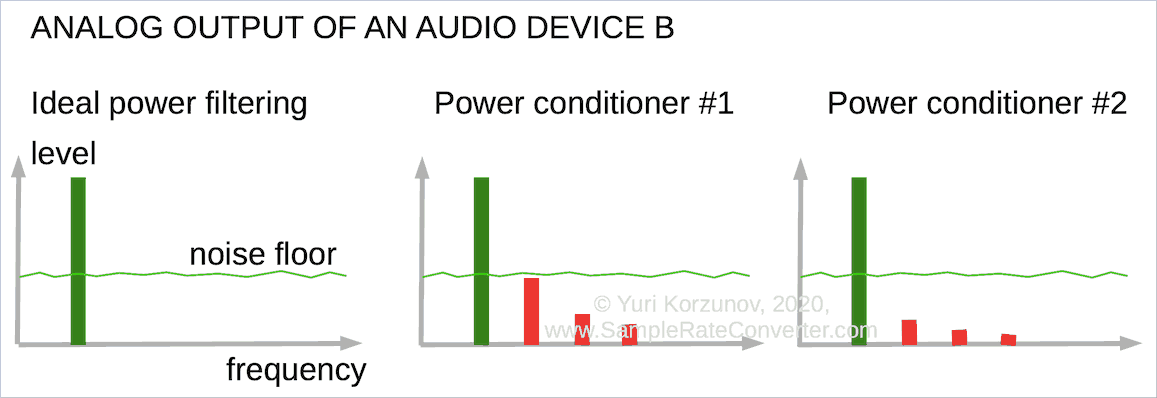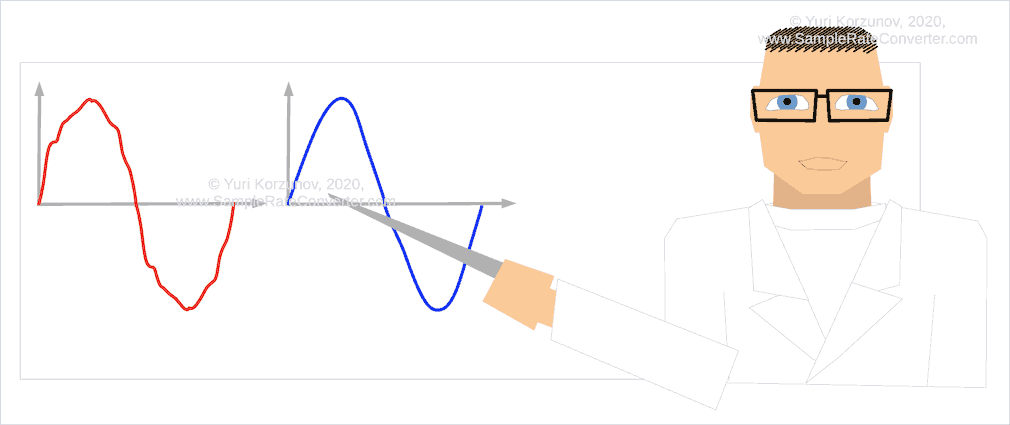
If you buy "AuI ConverteR PROduce-RD" (2023/12.x version) from 24 August 2023 to 24 October 2023, you will get free update to version 2024 (13.x) after its release.
Audio Basis - articles about audio
What is an audio power conditioner, purifier, surge protector, ups, stabilizer, power supply unit? Does it improve sound quality and reduce noise or it is "snake oil"? Do I need a power conditioner for audio and music? What really happens inside hi-fi equipment? What is the best power conditioner for an audiophile?
Technically, the conditioner action may be demonstrated most easily. But it's not that simple. Keep reading.
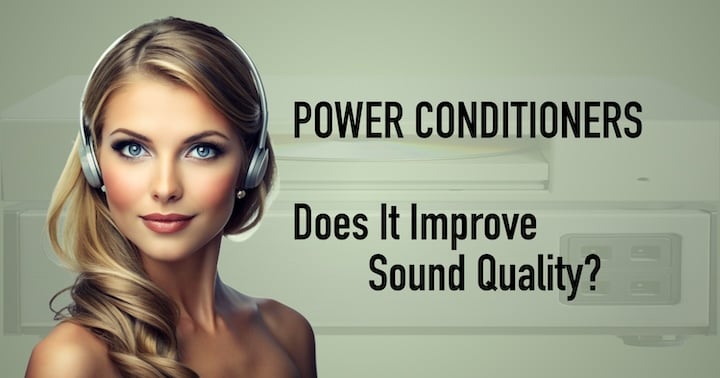
- What is a power conditioner in audio?
- Voltage stabilizer (voltage regulator)
- Surge protector
- Uninterrupted power sources (UPS)
- Power filters and others
- Abbreviations
- Why do I need a power conditioner?
- Noise spreading into an audio apparatus
- How power conditioning works
- How to estimate power conditioner
- How to choose the best power conditioner for audiophile equipment
- Batteries vs AC power supply units
- Dedicated power lines for musical apparatus
- Do you need a power conditioner for audio? Conclusions
- Frequently asked questions
WARNING!!! Read carefully before any audio tests. Listening of audio equipment, especially at higher volume knob positions, can cause ear damaging. Avoid any discomfort. Always consult your doctor before ear tests. Higher volume knob positions of an audio equipment can cause damaging of the equipment. Before any audio tests consult the equipment vendor or manufacturer.
Back to topWhat is a power conditioner in audio?
Power conditioner is a device, that cleans its input AC energy with some quality. It may be viewed as waveform, noise and/or distortion level of electrical supply oscillation.
What does an audio power conditioner do? There is no single definition. This device may include one or several types of functionality:
- voltage stabilizers;
- surge protectors;
- uninterrupted power sources (UPS);
- electrical suppliers with sine output;
- filters and others.
When we adjust the power supply and audio unit connection, we should keep in the mind proper grounding and cable shielding. Ferrite rings may be effective too. Because these additional measures are very important aspect of hum/noise suppression at outputs of audio equipment. Only all these things together provide an effective way of sound quality improvement.
Voltage stabilizer (voltage regulator)
Input voltage value may vary over time (unstable). As example, it happens due to load re-distribution in a power network.
A voltage stabilizer support output value in the allowable range (about 110 or about 220 Volt) to protect supplied equipment against damage.
When the input value is outside the extremal range, the stabilizer turns off output energy.
Laboratory voltage regulator allows setting output voltage value.
Surge protector
Due to commutation processes in a power network, voltage pulses have risen. It is significantly shorter variations, comparing the instability, that is solved by voltage stabilizer.
Surge protector filters these pulses at its own output. But it doesn't compensate for slow changes, like the stabilizer.
Uninterrupted power sources (UPS)
Power network energy may disappear due to different reasons. An uninterrupted power source contains accumulator, that is charged by input energy. When it's broken, the accumulator feeds an inverter module, which converts DC from the accumulator to high-voltage AC at the output.
When the accumulator is discharged, UPS is turned off. It can automatically send a message to special software at a supplied computer to finish work. Also, UPS gives a sound signal, that notifies a human, that it is necessary to shut down the computer manually.
Some UPS may work up to several hours. As rule, external accumulators are there.
Other uninterrupted power systems keep the energy supply until the start of a petrol generator's engine. These systems have lesser accumulator capacity, in comparison with the ones noted above.
The time of accumulator work depends on the UPS load. Read more in F.A.Q.
Power filters and others
Many UPS and stabilizers, pass-thru input voltage value to output without changes, when the input value is in the allowable range.
When the input value is out of the range, the output voltage may be replaced to a synthesized alternative current. The waveform of the synthesized voltage may be non-sine (example: square). Some power conditioners may synthesize the sine waveform. Such units, as rule, have a higher price.
Power line wires receive radio and other sources of interference. Their products can come to the power input of an audio apparatus. Some conditioners filter these products. Practically, in many cases, these products are filtered into power supply units of the audio devices.
When several devices with high-frequency (HF) sources are connected in a single energy-system circuit, each of the devices can "share" their own HF interference with other equipment via cables as wires and/or as antennas. Filters, based on ferrite rings, convert a radio-frequency electromagnetic field to warmth and rid of the cable interference.
Read frequently asked questions and more details below.
Back to top
Abbreviations
Why do I need a power conditioner?
What does power conditioning results look like?
Pure sine 50 or 60 Hz is a reference waveform of alternating (AC) electrical current.
However:
- distortions and ambient interference are added to the sine when the current spread thru wires via:
- air or
- power network connections;
- transformers, electrical motors and other equipment generate pulses in switching modes.
Such "dirty" AC from an electrical outlet feeds home or studio audio apparatus.
Power conditioner (PWC) eliminates (in some approach) the pulses, distortions, noise entering from an energy supply network. The conditioner may reduce average-voltage variations in time due to the commutation of supplied equipment. Read the overview of the conditioning functionality...
Conditioning of an electrical power
At the drawing
- waveforms and
- its spectrums
(theoretical, before and after power conditioner) are shown.
Red lines are different types of harmonical distortions. A conditioner suppresses these distortions. Some conditioners may synthesize sine voltage.
These plots are not real and demonstrate the principle. The harmonic level depends on the input waveform and the conditioner abilities.
Power supply and sounds quality
If power supply filtering, shielding, grounding is bad, it causes many different kinds of hum. It may be checked at higher volume knob positions during the listening of a recording silence or stopped playback.
If electrical energy supply doesn't keep voltage level for increase (or a sharp increasing in short-term) of electrical load, it can cause non-linear distortions (the author would call it "dirty sound"). The technical details read below.
Here we mean DC low voltage of energy supply, that directly feeds audio circuits.
Sound quality is noise and distortion level at an analog output of a musical device.
Noise from wires can penetrate to an audio output:
- add noise and/or
- modulate a musical signal.
Below we'll study an audio system structure to better understanding how it works.
Power quality and digital audio
Bad power quality may cause errors in digital data circuits. It can cause distortions of an analog signal, that converted from the digital data.
Commutations in digital circuits can cause interference in energy supply wires and impact on analog and digital circuits.
Also, read about jitter issues...
How to connect and use a power conditioner
A power conditioner (PWC) is connected to an electrical network outlet.
At an output outlet of the PWC, alternating current is filtered (sine purifying). The current feeds heterogeneous home or musical equipment, including studio ones.
Power conditioner abilities (depend on implementation)
- An automatic voltage regulator (stabilizer) is the very recommended ability for audio and studio equipment. It may be sensitive to deviations of voltage.
- A pulse protector defends an audio apparatus against overvoltage pulses.
- A noise filter removes different air (caught on wires) and other interferences.
- An isolation transformer implements galvanic isolation to electrical noise suppression. The transformer break so-called ground loops [1], causing additional currents in an energy line. Theoretically, the transformer (as a coil) may improve surge suppressing.
- Remover of a constant component of the input voltage. The component causes additional heating of electrical transformers into a power supply unit of an audio device.
There is no standard definition of "power conditioner" term.
Various devices, from the simplest pulse protector to complex multifunctional one, may be considered as a power conditioner.
Since conditioners may have different functionality, you need to check its specification mandatorily.
Audio equipment should be connected to output outlets of the conditioner. Connect grounding according to the conditioner's documentation.
Back to topNoise spreading into an audio apparatus
Noise spreads 2 ways:
- electrical energy supply wires,
- air.
The wires conduct more interference than radiation through the air.
Spreading ways of electrical noise
Back to top
How power conditioning works
In the simplest system, the power conditioner feeds a single device.
Power conditioned system
From the AC-energy line, "dirty" electrical voltage feeds the conditioner.
Over-voltage pulses are suppressed by the surge protector. It allows protecting against the audio-device damage.
The auto voltage regulator keeps long-term voltage changes in the given range at the output of the conditioner unit.
The noise filter suppresses high-frequency harmonics.
In the extremal case (too high or extremely low voltage), the conditioner can break the input-line connection. It protects the audio appliance and the conditioner against damage.
Some conditioners are capable synthesize a sine at the output.
However, often UPS output waveform is square.
The conditioner unit may have an internal accumulator battery (UPS functionality). In the extremal case, the unit may switch the audio device feed to DC/AC converter, that fed by the accumulator[2].
UPS design types
Example of design of switched uninterrupted power source
Alternatively, the DC/AC converter can feed an audio apparatus permanently.
Example of design of UPS with a permanent generation of AC-voltage
Only some models of conditioners provide sine voltage at output outlets. Carefully read the unit specification and manual.
Noise spreading through a power supply system
Noise and voltage variations of external energy network pass through a power conditioner with some reducing.
Noise spreading thru a power conditioning apparatus
Power supply unit (PSU) inside the audio device, transforms high-voltage alternating current to low-voltage direct one.
Noise partially passes through the power supply unit and penetrate to low-voltage DC-line.
The unit generates own interference. Thus, external noise (from AC input) and own PSU's hum should be considered separately.
Further, the cumulative noise comes to analog and digital parts through the internal DC energy buses. Also, the digital part generates own interference.
The analog part under a musical signal also affects to the low-voltage line. Because active element (transistor or tube) switching change currency and, respectively, voltage into electrical energy bus, that feeds the part.
- Therefore, the energy supply system is a comprehensive thing with several interference sources and feedbacks.
- Total noise in low-voltage energy lines (including penetrated external AC interference and variations) affects the audio output.
- To estimate power quality, we should check the interference spectrum and level at the analog output of audio equipment.
Back to top
How to estimate power conditioner
To estimate the quality of a power conditioner unit, we can compare interference at the analog output with and without the unit.
If the difference is invisible, we can use the unit as a surge protector.
Measurement of the conditioner impact to sound quality (noise level)
In general, the functionality of a power supply unit of audio device is the same conditioner:
- surge protection,
- high-frequency noise filtering,
- automatic voltage regulation.
Other hand, a conditioner may:
- provide a wider AC voltage range,
- be better as a surge protector.
It means, that the conditioner may be capable provide better conditions for the power supply unit of an audio apparatus.
The conditioner abilities may be estimated via power-line noise meter. It plugs into home and conditioner outlets and displays both noise values. If the conditioner works properly, interference at the conditioner outlet should be lesser, then at home one.
- Noise suppression at AC input of the audio device is not the final aim.
- The final aim is sound quality increasing (noise at the analog output of an audio appliance by AC energy source).
So we should check the interference level at analog output first.
After it, we can learn the spectrum of energy lines before PSU of an audio device.
To reduce the interaction of analog device parts through the low-voltage energy buses, line isolating filters are applied.
Power system structure with noise-isolating filters
The filters reduce AC part of the bus voltage and reduce the penetration of the AC part to the analog output of the device and between the parts.
Back to topHow to choose the best power conditioner for audiophile equipment
First, you should define for yourself:
- Do you want the best power quality before AC-input of audio equipment? or
- Do you want to minimize the impact of the quality to sound quality in your speakers or headphones?
- Do you want to protect your apparatus against damage by energy network deviations?
Case #1 is purely abstract and does not refer to sound quality.
Case #2 is an actual issue, that solved via power filtering, grounding and other measures.
Case #3 may be solved more simply and cheaply, than case #2.
Above we have considered how to check the real impact of the conditioner to the audio appliance.
It is a comparison of noise and harmonics at the analog-output spectrum of the audio system with and without the conditioner.
Also, we can check it for different kinds of test audio signals to check the conditioner under dynamic load (altering the conditioner-output load during a time).
There are maybe cases:
- No difference;
- Altering of noise and artifact level.
If a conditioner doesn't provide the difference, it does not matter that conditioner you use.
When conditioners cause different interference levels at the analog output of feed appliance, conditioner with lower noise/harmonic level is preferable.
To be exact, we can correct the noise/artifact measurement result according to the ear's frequency-sensitivity curve. But your ears may have the curve form different from averaged one.
The simplest way is ear checking of interference at higher volume knob positions during the listening of a recording silence (zero level) or stopped playback.
Example
Let's compare:
the analog output of the audio device A, that is connected to conditioner #1,
with
the analog output of the audio device A, that is connected to conditioner #2.
For ideal power filtering, we should view the only useful signal and the noise floor at the spectrum of analog output of a device A.
When device A is connected to conditioner #1, we can observe some harmonics, with unknown genesis, above the floor.
When device A is connected to conditioner #2, we can observe these or other harmonics, above the floor, but with a lesser level.
Resume:
So, we can suggest, that conditioner #2 is more appropriate for device A.
Now let's compare:
the analog output of other audio device B, that is connected to conditioner #1,
with
the analog output of audio device B, that is connected to conditioner #2.
When device B is connected to conditioner #1, all harmonics below the floor.
When device B is connected to conditioner #2, all harmonics below the floor too.
Resume:
So, we can suggest, that no difference between conditioners #1 and #2 for device B.
Back to topBatteries vs AC power supply units
There is an opinion, that batteries can fully solve hum and interference issues, unlike AC power supply units (PSU).
But:
- Batteries may require frequent replacement for the charging procedure.
- Qualitative PSU's filter and other measures solve the hum/interference issue successfully.
- Despite the unit have air interferences, the air is not so significant path of the interference as spread via wires, that solved in goal 2.
It is not necessarily fully suppress hum in energy wires into an audio appliance. If no measurable artefacts at the analog output of the device, such a filtering level is enough. And it does not matter batteries or AC PSU are there.
When you can't measure a spectrum, you can compare the audibility of noise/hum components at a high volume level for both batterie and AC-adaptor feedings.
WARNING: be careful, accidental playback start, any switchings or other signal rising at high volume can damage ears. Set minimal loudness when doing any switching and others.
Dedicated power lines for musical apparatus
Somebodies try to solve issues of sound quality improvements via dedicated power lines.
If the line is just wires, there is no sense to do it.
WARNING: Any kinds of power-network applications and works require special knowledge. All these works should be performed by professionals.
Electric tension stability
Primarily, the author would recommend providing stable electric tension.
If your home is fed a three-phase electric line, you should distribute the load evenly between these phases.
Practically, heterogeneous home equipment has a significant load and periodically switched. As example: electrical oven, refrigerator, etc.
It causes load re-distribution. And each of the phases may have different tension. The more load difference the more pressure contrast.
If your equipment is sensitive to the variations, the stabilizer should be used as a source of the dedicated line.
As rule, an audio apparatus is not a big load. And a single-phase connection is recommended.
WARNING: Multiphase connection is sophisticated and may require a special approach to avoid different kinds of damage.
Surge protection
Surge protection is recommended with and without the stabilizing.
Noise filtering
As rule, high-frequency filtering is not a big matter. Check its necessity this way.
Back to topDo you need a power conditioner for audio? Conclusions
- Sound quality may be defined as noise and distortions at the analog output of audio equipment.
- "Clean" AC, supplying an audio system, is not target on its own.
- A single way to estimate the impact of AC power quality to sound quality is interference measurement at the analog output of an audio device or system.
- Both, power supply unit of an audio appliance and the conditioner, have the same functionality.
- But power conditioner may have a wider allowable range of AC-parameter deviation and provide better conditions (keeping proper electrical mode, surge protection) for the PSU.
- Practical "home" way to check a conditioner effectivity is check noise/hum at high amplifier volume when playback is stopped.
WARNING: be careful, accidental playback start, any switchings or other signal rising at high volume can damage ears and equipment. Set minimal loudness when doing any switching or others.
Frequently asked questions
F.A.Q. power conditioning
What is meant by power conditioning?
Power conditioning means several things: surge protection, noise filtering, others. Read more...
What does a power conditioner do for audio equipment? What does a power conditioner do?
A power conditioner improves the power supply of audio equipment.
Read more...
What is audio power filter?
In general terms, audio power filter clean power supply voltage form and level.
Filtering may mean cleaning of power voltage from noise.
Read more...
What is a power conditioner audio?
A power conditioner is a device that filters the power supply of an audio device.
Read more...
Is a power conditioner the same as a surge protector?
Surge protector tries to suppress high voltage peaks. It can break the AC circuit when the peak is too long and/or too high.
A power conditioner has many definitions. Depending on implementation, the conditioner may work as surge protection.
Read more details...
What is a voltage regulator?
Voltage regulator is a power supply device, that supports voltage within a specified range.
Read more...
What is a discrete voltage regulator?
Discrete voltage regulator is a voltage regulator assembled on discrete electronic components.
In the first approach, these voltage regulators may outperform on-chip regulators for output load and noise.
Read more...
What is a line stabilizer conditioner?
Line stabilizer provides output AC voltage value in a defined range. If the input value is too high or low, the stabilizer turns off the output supply. The appliance may be combined with a surge protector and an uninterrupted energy supply. The algorithm of the work of the stabilizer depends on its implementation.
Read details...
Is a power conditioner the same as a surge protector?
Surge protector tries to suppress high voltage peaks. It can break the AC circuit when the peak is too long and/or too high.
What is the difference between a power conditioner and UPS?
A UPS (uninterrupted power supply) primarily provides output energy when the input supply disappears.
But, practically, UPS may include the conditioner functionality:
- voltage stabilizing,
- surge protection,
- etc.
Read details...
What is HIFI power filter?
As rule, hi-fi power filter is a device that filters noise and, sometimes, voltage pulses in a power network. The author is not sure that noise suppressing is actually for feeding of power supply unit of an audio device. But, pulse suppressing may prevent equipment damage.
The author recommends using a voltage stabilizer for easier work conditions and defense of the audio setup against damage.
Of course, remember, that the actual necessity of noise filter is studied practical way primarily via ears and/or measurements.
What is the difference between a power conditioner and a surge protector?
A surge protector is one kind of power conditioner.
Do power conditioners save energy?
No. A power conditioner causes energy losses in its own electrical circuits.
F.A.Q. why power conditioner is need
Do hifi mains conditioners work?
Do mains conditioners really work?
Conditioner may impact to sound quality of connected audio device. However, only complex approach with measurements can help to achieve the best result. Read more...
When should you use a power conditioner?
If you have noise at audio equipment's analog output, you are need study and apply emasures to fix it. Power conditioner may fix some aspects of the issues.
Read more...
Why power conditioning is needed?
When analog output of an audio system has additional noise, you are need to learn why it happens. Power conditioner is one of options to solve full or part of the issue.
Read more...
Do power conditioners actually work?
Yes. Result of power conditioner's work may be measured.
Read more...
How important is a power conditioner?
Power conditioner should be appropriate connected audio equipment. In this case it can give advantages.
It some cases the conditioner is not need.
Read more...
How do I get clean power for audio?
"Clean power" means power voltage as pure sine. It is achieved via low frequency filtering, grounding, ferrite filters.
Has it sense or not depends on power supply unit and schemes of protected audio unit.
Are audio power conditioners snake oil?
It depending what you expect from an audio power conditioner. First, the conditioner can protect a sound unit against damage.
Power filtering may work after experimental tuning rather, in complex with other decisions (cable placement, grounding, etc.).
F.A.Q. sound quality
Is a power conditioner worth it? Do I need a power conditioner? Are power conditioners worth it?
If your home AC energy system is low qualitative (high level of voltage deviation), a conditioner with stabilizing ability is very necessary.
Also, high voltage peaks may cause audio equipment damage. Some conditioners may truncate these peaks.
Short and unexpected energy supply breaks also can cause equipment damage. Uninterrupted energy ability can protect the apparatus.
Read more details...
Does a power conditioner improve sound quality?
The conditioner may impact (depend on implementation) to interference level and, sometimes, the voltage into energy wires inside a supplied audio apparatus.
But, as rule audio appliances have an inner power supply unit, that stabilizes voltage and filter noise from its input. And conditioner filtering does not matter.
Read details...
Do power conditioners reduce noise? Does power conditioner reduce hum?
A power conditioner is capable to reduce noise at audio output of supplied device for some cases.
Read more...
Which voltage regulator is best?
Voltage regulator is designed/choosen according to requirements of an electronic device that planned for supplying.
First requirement is load value (W and/or VA)
Excessive abilities of the regulator cause additional cost without technical point.
Read more...
What is the best power conditioner?
Best power conditioner provides at the output:
- minimal-distortion-and-noise sinusoidal signal with
- voltage and frequency according to local electrical requirements.
However, its actual impact to sound quality depends on your equipment, quality of AC-energy system and shielding, grounding of the apparatus.
Read more details...
Does power conditioner eliminate hum?
A conditioner may be capable to filter interference at its own AC output line. But supplied audio appliance contains own energy supply unit, that provides such filtering. As rule, the unit successfully solves the hum issue.
Read details...
How do I clean my AC power?
The author recommends primarily use:
Also, some supplied audio equipment may be sensitive to waveform/distortions of energy-supply voltage. And sine waveform of the conditioning-unit output may be desirable in this case.
Necessity and degree of power purification may be defined by the manual of the audio apparatus or estimated by measurements.
Read more...
What does 1000VA mean on a UPS?
VA (Volt * Amper) is a measurement unit of complex electrical power.
It defines electrical load at the output of the uninterrupted power source.
Maybe you heard about W (Watt) unit. It is an active power.
The active power of a 1000VA UPS is lesser than that value.
Example: If your audio device marked as 1000W then you need UPS, which supports more 1000W. Such an uninterrupted power source always provides complex power more 1000VA.
Why is using UPS recommended? Do I really need UPS? Is UPS worth it?
Uninterrupted power source protect supplied equipment against damage due to electrical voltage deviations. There are several kinds of protections.
If your electrical energy supply is proper and has no interruptions, UPS is no need. As example, your building supplied by own safe power station, that:
- stabilize voltage,
- have reserve energy supply and
- other.
If you supplied apparatus is very critical to unexpected AC supplying off (data losses at server or desktop computer, as example), UPS is mandatory.
Read details...
How big a UPS do I need?
An autonomous time of work of uninterrupted power source (T, s or second) depends on load (L, W or Watt) and accumulator capacity (C, Ah or Amper*hours).
T = C / (L/U) * K.
K is coefficient, that accounts the losses in the UPS. It always lesser 1.0.
If the power of an UPS (VA) in VA, L(Watt) = VA * cos(θ).
Where cos(θ) (cosinus of θ) is value defines active power. The value may be noted in UPS documentation.
As rule, UPS manual contains an approximate time of work for different loads.
The time may be expanded when a UPS allows connecting of additional accumulators (including external ones). Some units may use an automotive accumulator.
Read about UPS...
How do I get clean power for audio?
Primarily, power cleaning is matter of inner power supply unit of an audio unit. To aid, we can add power conditioner at AC supply input of the unit.
Read more...
Do power conditioners work for audio?
At least, a power conditioner may works as supply protector of an audio device against damage.
Read more...
Noise reduction at an analog output of the device requires engineer approach with control of the conditioner actual effect.
Read more...
Is a power conditioner better than a surge protector?
Power conditioner may contain or do not a surge protector. Also, the conditioner may including other devices.
Required power device kit may be found via engineering calculation and experimental adjusting.
It is unlikely that power conditioner give advantages comparing surge protector in all cases.
But, sometimes, more complex power protection is need. In instance, for unstable power voltage.
Read details...
Do surge protectors filter power?
A surge protector suppress (filter) short pulses of power voltage. It may be done with gas discharging tube (plasma surger aresters), in instance. The surging may be combined with high frequency filtering.
How long do power conditioners last?
Operational lifetime of a power conditioner should be noted in its user guide.
If the conditioner works in hard conditions (wide input voltage range, high environment temperature, humidity), the lifetime may be reduced.
Theoretically, the conditioner may be tested via measurement tools periodically. But. it's problematic to apply in home conditions without special skill.
Are power filters worth it?
If your home power network is not qualitative, power filter allows reducing noise at analog output of an audio device.
However, it is sophisticated multi-factor matter. Your device is important thing impacting real effect. And, there is no simple answer the question.
Read more...
Do power conditioners improve audio?
In some cases, power conditioner can improve audio quality.
Read more...
Do I need a power conditioner for my stereo?
There is no common answer the question. If power quality of your network is bad, power conditioner may help.
However, the power has several parameters. For each parameter, certain conditioning type is designed.
Also, you device may be tolerance to the power quality. And, additional conditioner device is no need.
Read more...
- Bill Whitlock. Understanding, finding, & eliminating ground loops
- High-Availability Power Systems, Part I: UPS Internal Topology
- What is Jitter in Audio. Sound Quality Issues >
- 64-bit audio processing. Necessity or redundancy >
- What is Audio Converter >
- How to Choose the Best Audio Converter Software >
- What Is Ringing Audio >
- What is dithering audio? >
- Bit-Depth Audio and Harmonic Distortions >
- Audio as Optics >
- What is optimization audio for DAC >
- Where is the Limit of Audio Quality? >
Back to top
